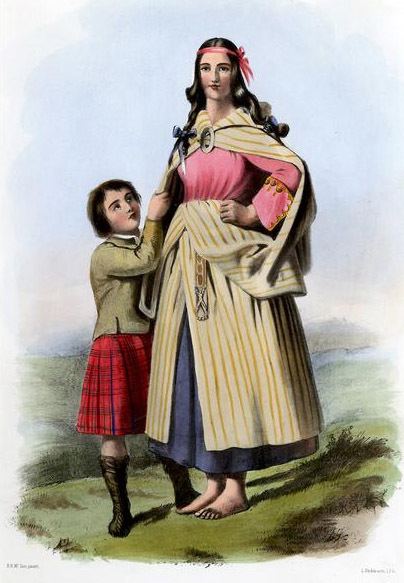 | ||
See also Highland dress, belted plaid.
Contents
An earasaid, or arasaid is a draped garment worn in Scotland as part of traditional female highland dress. It is a belted plaid (literally, a belted blanket). Unlike belted plaids for men, it is worn at ankle length. Traditionally, it might be plain, striped or tartan; it might be brightly-coloured or made of lachdan (dun or undyed) wool. Modern highland dress makes earasaids from the same heraldic tartan cloth used for kilts.
Overview
In cut, it is a rectangle, longer than the wearer is tall, and wider than the wearer's waist circumference. The bottom edge is ankle length and the top edge hangs cape-like behind, or is used as a hood. The width is pleated until it will wrap around the waist with a small overlap. The pleats are held under a belt. The cloth below the belt hangs like a skirt; the cloth above the belt may be pinned or pulled over the head.
Near the end of the seventeenth century, Martin Martin gave a description of traditional women's clothing in the Western Islands, including the earasaid and its brooches and buckles.
"The ancient dress wore by the women, and which is yet wore by some of the vulgar, called arisad, is a white plaid, having a few small stripes of black, blue and red; it reached from the neck to the heels, and was tied before on the breast with a buckle of silver or brass, according to the quality of the person. I have seen some of the former of an hundred marks value; it was broad as any ordinary pewter plate, the whole curiously engraven with various animals etc. There was a lesser buckle which was wore in the middle of the larger, and above two ounces weight; it had in the centre a large piece of crystal, or some finer stone, and this was set all around with several finer stones of a lesser size. The plaid being pleated all round, was tied with a belt below the breast; the belt was of leather, and several pieces of silver intermixed with the leather like a chain. The lower end of the belt has a piece of plate about eight inches long, and three in breadth, curiously engraven; the end of which was adorned with fine stones, or pieces of red coral. They wore sleeves of scarlet cloth, closed at the end as men's vests, with gold lace round them, having plate buttons with fine stones. The head dress was a fine kerchief of linen strait (tight) about the head, hanging down the back taper-wise; a large lock of hair hangs down their cheeks above their breast, the lower end tied with a knot of ribbands."
Historical example
Christina Young spun, dyed, and wove a surviving tartan plaid; it has the year "1726" and the maker's initials stitched into the edge.; it dates from before the Highland dress was banned. A reconstruction in the Scottish Tartans Museum is displayed worn as an earasaid (image link).
